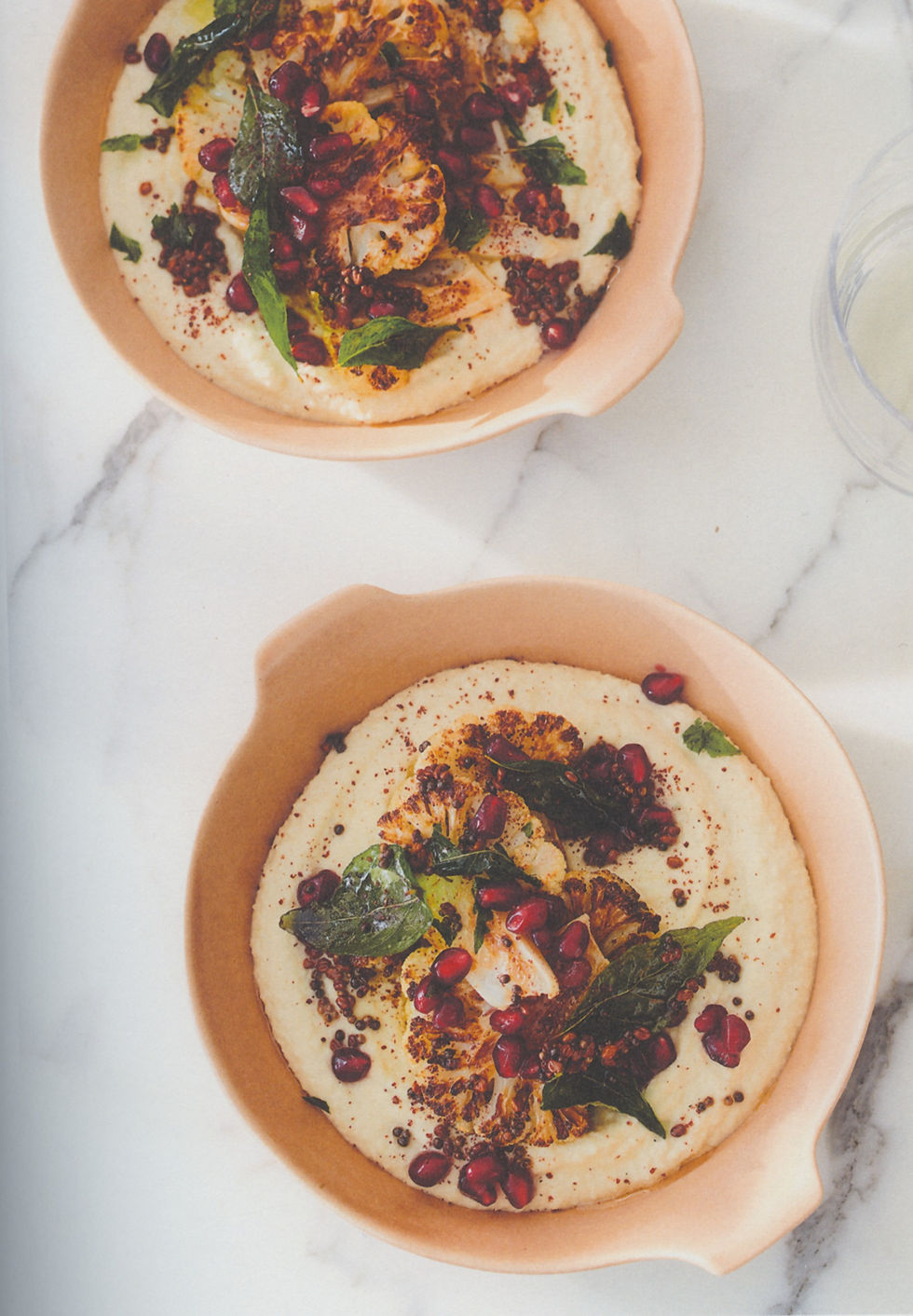Ajo blanco - I'm confused
- rosemary
- Sep 1, 2022
- 6 min read
Updated: Sep 2, 2022
"Despite the name of the soup, garlic is rarely the principal ingredient in ajo blanco, which I would characterise instead as an almond soup."
Felicity Cloake

Ajo blanco is a Spanish classic cold soup that translates as 'white garlic'. However, it is generally thought of as a cold almond soup - lots of people describe it as such. And to add to the confusion there are also garlic soups - I'll get on to the non-soupy versions later.

I think Felicity Cloake nails what it's supposed to consist of when she does her 'perfect' thing saying that it is:
"Stale bread, moistened with vinegar and water, thickened with nuts and spiced up with garlic"
The nuts being almonds - unpeeled ones.
Now I'm not generally a fan of cold soups. I prefer my Vichysoisse warm, I can take Gazpacho or leave it, and cold fruit soups are just wrong somehow. Cooling yes, all of them, but not quite right. But I'm writing about this because of a series of small coincidences in recent times.

Where to begin? Perhaps with Bill Granger's Roast cauliflower with pomegranate, ajo blanco & curry leaf oil, which I picked recently as my 'new' recipe for the week because I had some cauliflower to use. Alas the recipe is not online - you will have to buy the book - Australian Food - or ask me. I can send you a copy. I think I have written about it before somewhere because it was so good. But as you can see it is not a soup. It's more a dip like mixture with the roast cauliflower, etc. on top à l'Ottolenghi. Well everyone's doing it these days. The only thing that is missing from his recipe from Felicity Cloake's list is the stale bread and water, so I guess it's just a thickened version of the soup.
Anyway it got me to vaguely thinking of investigating what Ajo blanco really was.

But around the same time The Guardian newsletter came up with this rather scrumptious looking Creamy milk and roast garlic soup with manchego and green olive toast from José Pizarro who seems to be a Spanish food chef in Britain. Now here we have soup - garlic soup even, and yes a massive amount of garlic is involved - 2 whole garlic bulbs, plus milk, olive oil, pimentón, stock and breadcrumbs. But no almonds or nuts of any kind. This is indeed garlic soup - and to be fair he makes no pretence of calling it Ajo blanco. But it is creamy and involves garlic, so there is a connection there. And it isn't cold.
I will jump a little here to today's researches. I first went to my bookshelves and picked out Robert Carrier's Great Dishes of Spain. And opening it, as directed by the index, to pages 82 and 83 I was confronted with two versions of Sopa de ajo (garlic soup) and one of Sopa de almendras (Almond soup), but no Ajo blanco. The plot thickens as it were. His first garlic soup he describes as:

"This is the real peasant soup of Spain. Richly flavoured, satisfying and soul-warming when served with an egg poached in it and garnished with tiny spares of serrano ham, it is almost a meal in itself."
His recipe is not online of course - he is unloved these days, but this version is very similar and is from Serious Eats' Nick Kindelsperger. Carrier's second version is a variation that includes tomatoes and egg whites, although, as he says: "there as many ways of making garlic soup as there are cooks in Spain." And I'm sure you could say the same of any classic dish anywhere.

His Sopa de almendras might be an almond soup but it is not Ajo blanco. It sort of starts out with the same ingredients but there's tomato purée, saffron, cumin and paprika in there too and a garnish of parsley, almonds, shredded lemon peel and garlic croutons. I think this picture is the nearest to what it might have looked like, but the recipe is in Spanish I think and anyway the site would not load.
So there are obviously Spanish garlic soups and Spanish almond soups, in addition to Ajo blanco which is different again.

Oh and here is my final coincidence. My next First Recipe cookbook is Jane Grigson's English Food, and the first recipe is Almond soup, shown here as cooked by Neil Cooks Grigson. Yes English food, not Spanish. However, when she talks about the soup's origins I began to see a sort of connection which I shall explain in a moment:
"A beautifully white soup which goes back to the cookery of the Middle Ages, the courtly cookery of England and France (the French name is soup à la reine). Almonds then played an even larger part in fine dishes than they do today. As well as its flavour, this soup has the advantage of being made from the kind of ingredients that most people have in the house in summer or winter: perhaps this is another reason why it has survived so many centuries, not just in palaces but in the homes of people of moderate prosperity." Jane Grigson
It's a much richer soup than the Spanish version in that it is enriched near the end with cream, eggs and butter, and Neil of Neil Cooks Grigson, wasn't that impressed:
"I’m not convinced that I actually liked this soup, it was certainly nicer the next day when the flavours had time to develop. It’s certainly a posh soup, but I think it could’ve been improved by using a less salty stock"
But then for some reason, instead of using the chicken stock that she recommended he went to the bother of making a veal stock he got from elsewhere in her book, and that was very salty.
So what is this cold Ajo blanco supposed to be then, and where does it come from? Well the almonds to me say the Moors, but one origin story which, I have to say, is pretty convincing is even older:
"Roman soldiers carried bread, garlic, olive oil, vinegar, and salt as standard rations during the era of the Roman empire. One popular theory posits that Roman soldiers in the Andalusian area or Southern Spain would mash all of those ingredients together with some water to make a no cooking necessary soup." Slow Burning Passion
No almonds though. Maybe they got added when the Moors arrived. A peasant soup rather than a courtly one like Jane Grigson's, however. Well the peasants don't grow almonds in England do they?
Having now perused various recipes from my library and the net, I have now come to the conclusion that basically it is something you put in a blender and whizz - the something being stale bread, almonds - without their skins - water, some garlic according to taste - Felicity Cloake thought one for each person was enough - olive oil and sherry vinegar.
"I think the difference between a good ajo blanco and a great one lies in the generous addition of both olive oil and sherry vinegar" says Felicity
Then when you'd mixed it all up, chilled it - it needs to be very cold - you top it with some kind of fruit. Grapes seem to be traditional, but others suggest, apples, melon, kiwifruit and cucumber.
"the garnish elevates it from an everyday experience to something special. But with ajo blanco, it goes beyond that. The garnish—usually fresh grapes, but sometimes other fruit, like melon—completes it. Ajo blanco just isn't a fully realized dish until it's studded with juicy, sweet-tart bites." Daniel Gritzer - Serious Eats
Frank Camorra of Movida apparently tops his with a muscat grape granita which Felicity Cloake thinks is wonderful.
The apples and cucumber are sometimes blended in with the mixture. And some people of course use almond milk instead of water.
So here are a few to try if the weather ever warms up. It might be the first day of Spring, but it's pretty cool and dull and difficult to imagine sitting in the sun eating ice-cold soup so I won't be making it anytime soon. I have chosen five, from Mark Best; Serious Eats (Daniel Gritzer); Delia Smith of all people, Matt Preston who apparently lived in Spain when young, so should know what to do and, of course, Claudia Roden with her Ajo blanco con uvas from her comprehensive tome The Food of Spain.

Then there's this extremely pretty and not very traditional Cold almond, melon and pastis soup from Alex Jackson (with bits of crispy ham) which also coincidentally popped up in a recent Guardian newsletter. Well it's been a very hot summer over there in England, and so I guess something like this might be just the thing. I'm sure there are heaps of other similar recipes around. Add a little something to your basic mix - some cucumber or apple perhaps, and then add other stuff on top. I saw a few that featured things like prawns and crabs. And I have to say that almost all of these chefs seemed to think that Ajo blanco was the king (or queen) of chilled soups, with most of them preferring it to gazpacho. So perhaps I should give it a go sometime.
But sort of back to the beginning and Bill Granger's recipe. Whilst cruising Google's image library I came across these two very delectable looking dishes which made use of the ingredient concept but with less liquid: Lamb cutlets with mojo rojo, ajo blanco and pomegranate salad from Nieves Barragán Mohacho and Cucumbers with ajo blanco sauce from Andy Baraghan from Bon Appétit. That one, in particular looked like the perfect summer entrée. And I've just noticed the almost identical name - Barragán, and Baraghan.
Maybe it's the next hummus or tahini sauce.

















Comments